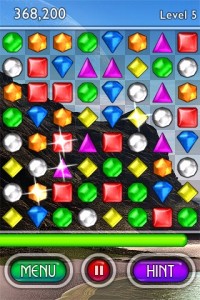 I’ve recently rediscovered my insatiable love for Bejeweled 2. For those of you who have never played, the gameplay is quite simple. Given a grid of random jewels, you must switch adjacent jewels to create strings of 3 or more. Bonus events occur when you get 4 or 5 gems in a row.
I’ve recently rediscovered my insatiable love for Bejeweled 2. For those of you who have never played, the gameplay is quite simple. Given a grid of random jewels, you must switch adjacent jewels to create strings of 3 or more. Bonus events occur when you get 4 or 5 gems in a row.
Pretty simple. Not rocket science. So why has the game been played and replayed hundreds of millions of times? What keeps people coming back to such a straightforward game?
The answer lies in the psychology behind the game. While the gameplay may seem simple, the psychology behind it certainly isn’t. Here’s why:
1. Difficulty level
Bejeweled may not require a PhD in pattern finding, but there is some level of skill required for the game. You have to practice in order to increase your skill in finding rows of jewels. With a learning curve in place, the player gets a sense of contributing to and earning the rewards, making them all that much more gratifying.
2. Randomness and unpredicability
Sure you can control which jewels to move, but you have no power over the placement of the gems in the grid. The jewels appear in a random pattern, so gameplay is new and different each time you play. Because of this, you can’t predict the outcomes. This keeps you constantly guessing as your dopamine neurons are jumping up and down in elation, quite similar to the effect gambling has on your brain.
3. Cascading effects
At certain points in the game, you might create a simple string of 3 jewels that sets off huge cascading effects, leading to multiple strings of 4 or 5 in a row. Other times, you might use a power gem to zap all the jewels of a certain color, but nothing else happens. Sounds like a slot machine payout, eh?
With all these psychological undercurrents, it’s no wonder Bejeweled is so popular. It creates a casino-like rewards system to make your brain feel good, all in the comfort of your own home. Pure genius.

